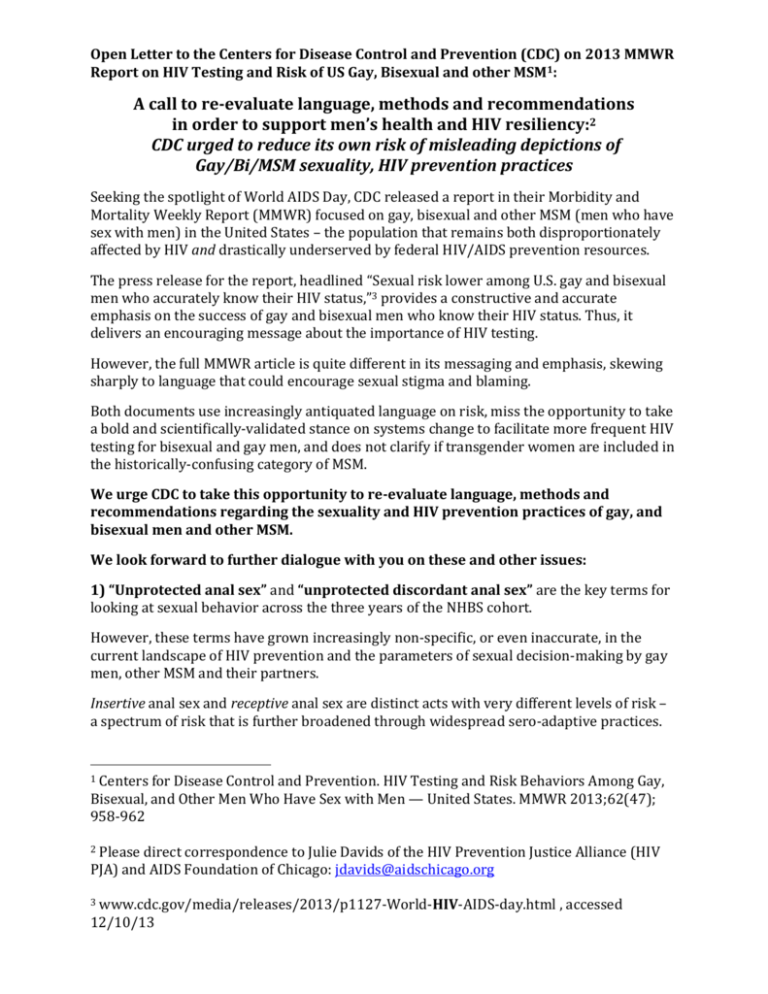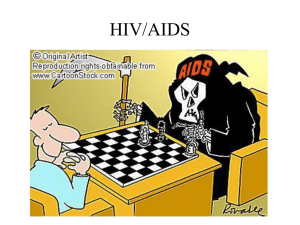
Open Letter to the Centers for Disease Control and Prevention (CDC) on 2013 MMWR
Report on HIV Testing and Risk of US Gay, Bisexual and other MSM1:
A call to re-evaluate language, methods and recommendations
in order to support men’s health and HIV resiliency:2
CDC urged to reduce its own risk of misleading depictions of
Gay/Bi/MSM sexuality, HIV prevention practices
Seeking the spotlight of World AIDS Day, CDC released a report in their Morbidity and
Mortality Weekly Report (MMWR) focused on gay, bisexual and other MSM (men who have
sex with men) in the United States – the population that remains both disproportionately
affected by HIV and drastically underserved by federal HIV/AIDS prevention resources.
The press release for the report, headlined “Sexual risk lower among U.S. gay and bisexual
men who accurately know their HIV status,”3 provides a constructive and accurate
emphasis on the success of gay and bisexual men who know their HIV status. Thus, it
delivers an encouraging message about the importance of HIV testing.
However, the full MMWR article is quite different in its messaging and emphasis, skewing
sharply to language that could encourage sexual stigma and blaming.
Both documents use increasingly antiquated language on risk, miss the opportunity to take
a bold and scientifically-validated stance on systems change to facilitate more frequent HIV
testing for bisexual and gay men, and does not clarify if transgender women are included in
the historically-confusing category of MSM.
We urge CDC to take this opportunity to re-evaluate language, methods and
recommendations regarding the sexuality and HIV prevention practices of gay, and
bisexual men and other MSM.
We look forward to further dialogue with you on these and other issues:
1) “Unprotected anal sex” and “unprotected discordant anal sex” are the key terms for
looking at sexual behavior across the three years of the NHBS cohort.
However, these terms have grown increasingly non-specific, or even inaccurate, in the
current landscape of HIV prevention and the parameters of sexual decision-making by gay
men, other MSM and their partners.
Insertive anal sex and receptive anal sex are distinct acts with very different levels of risk –
a spectrum of risk that is further broadened through widespread sero-adaptive practices.
Centers for Disease Control and Prevention. HIV Testing and Risk Behaviors Among Gay,
Bisexual, and Other Men Who Have Sex with Men — United States. MMWR 2013;62(47);
958-962
1
Please direct correspondence to Julie Davids of the HIV Prevention Justice Alliance (HIV
PJA) and AIDS Foundation of Chicago: jdavids@aidschicago.org
2
www.cdc.gov/media/releases/2013/p1127-World-HIV-AIDS-day.html , accessed
12/10/13
3
In addition, the use of virally-suppressive HIV treatment is a relevant factor in accurate risk
assessment and sexual decision-making.
In the report, unprotected is used to refer to the non-use of condoms. However it does not
mean that sex occurred in an environment of heightened HIV risk. Although much of this
data was collected before PrEP licensure, reports emerging today should use clearer
language – such as “sex without condoms,” rather than “unprotected.”
These distinctions are neither political nor semantic. They are integral to reaching the
goals of the National HIV/AIDS Strategy and curtailing the epidemic.
Gay, bisexual and other men who have sex with men and their partners need accurate
information for sexual risk reduction. There are noted methodological models for data
collection that effectively clarify and refine descriptions of sexual behavior that should be
adopted across research conducted or supported by CDC.
2) We agree that increased HIV testing is a priority, and that “the data suggest that some
men may benefit from more frequent testing.”
However, we believe that “at least annual HIV testing” that is only to happen more
frequently at provider discretion is insufficient in the current environment.
Once again, CDC has missed the opportunity to take a bold and data-supported stand in
favor of more frequent HIV testing for all gay and bisexual men and other MSM. Sticking to
the once-a-year standard, leaving it at providers’ discretion to advocate for more frequent
testing (which many do), is not warranted given the strong – and historically consistent –
findings of behavior change by those who test positive as well as the recognized role of
treatment as a prevention modality.
By formally recommending testing on a quarterly basis, CDC will encourage systemic
changes that will result in more men learning earlier if they are infected and allowing them
to make informed decisions about their health care and sexual practices. Individuals who
tend to lag behind in testing with the recommended interval will be prompted to test more
frequently.
A system that is set up to facilitate more frequent HIV testing is a resource not only for
case-finding and entry into care, but also to support the use of PrEP, which requires testing
every 3 months.
In addition, we support efforts at the time of testing that would help identify HIV negative
men who would benefit from access to PrEP and other prevention interventions, and
increased vigilance in opposing the stigma, discrimination and criminalization of those who
test positive.
3) We urge a reconsideration of the reliability of venue-based sampling for the gay,
bisexual and MSM cohort of the NHBS. CDC’s own research, as well as that of others, has
pointed to the significant shift of sexual networking and social structures to finding
partners online, and to greater integration of young LGBT people in networks that are less
segregated in terms of sexual orientation. Venues, if used, must be interpreted broadly to
include a wide range of non-commercial and commercial spaces, and even digital space.
Further, the highly urban-based sample continues to under-power for potential differences
in rural and Southern populations of gay, bisexual and MSM, despite rising incidence and
prevalence in the South and potentially significant differences in social and sexual
structures in non-urban areas.
4) We continue to recommend that CDC clarify the inclusion or exclusion of transgender
people in the NHBS, including the MSM cohort, and all other population research and
HIV/AIDS cohorts and studies. While we anticipate and commend significant
improvements in the collection and reporting of data on transgender people4 – including
transgender women who evidence high rates of HIV where data is available – the press,
policy-makers and the HIV/AIDS community must have clear information on how to
interpret the conclusions of all data vis a vis transgender populations.
5) While we recognize that CDC does not control how the press communicates its policies
and findings, we are concerned (though not surprised) that major news stories on the
MMWR did not reflect the messaging of the press release. We encourage a coordinated
and clear press strategy, including op-eds by top CDC officials and HIV/AIDS leaders,
press briefings and other modalities, to eschew the biases that can come up in these stories.
However, it is most important that CDC avail itself of all opportunities to ensure that the
source documents, such as the MMWR itself, are free from overt or covert
stigmatizing language in its descriptions, findings and areas of emphasis.
6) In an era of expanding prevention options, it is nonetheless imperative to continue to
make condoms (and safe, condom-compatible lube) accessible and invest in prevention
education for gay and bisexual men and other MSM to increase their capacity to meet
their own goals for sexual health and safety.
While many gay men continue to use condoms frequently and consistently, we may be
seeing gay men feeling more comfortable being honest about the challenges of condom use
(which are reflected in effectiveness rates cited by CDC) -- and must do whatever is
possible to encourage this honesty and rejecting the stigma that may come towards those
who speak up.
CDC must supply and encourage respectful, unbiased, and accurate data and messaging not
only on male condoms but all HIV prevention technologies and practices, including serosorting and sero-positioning, that people are using to mitigate risk.
Increased knowledge and uptake of PrEP and PEP, sero-adaptation, and the development of
integrated systems of care to facilitate their use will take significant resources and
coordination, including education and training of primary care physicians.
7) The MMWR releases was a missed opportunity for CDC, along with federal partners, to
reinforce the importance of essential services to support individuals who test
positive across the HIV care continuum, and to articulate a cogent HHS-wide strategic
approach to ensure that gay, bisexual and other MSM achieve viral suppression. As you
know, the HIV Care Continuum is a planning model that identifies issues and opportunities
for improving the service delivery of services and health outcomes for people living with
HIV. As such, it is increasingly used by both government and non-governmental
stakeholders. Helping individuals across the continuum of care achieve requires attention
to psychosocial issues; identification, prevention and treatment of mental health and
substance use disorder; provision of housing; efforts to mitigate HIV stigma, discrimination
and criminalization; and employment opportunities and work force re-entry support for of
HIV+ persons.
8) Finally, we stress that continued rigor is needed on the part of CDC, and its federal
partners, to assure greater concordance between resource allocations and the
4
http://www.cdc.gov/hiv/risk/transgender/ accessed December 17, 2013
populations most affected by HIV, including robust and up-to-date and affirming HIV
prevention efforts by and for gay and bisexual men.
We come to you as partners for constructive dialogue and change. We look forward to
engaging with you on these and other issues in order to ensure significant, necessary shifts
in language, funding, research and communication practices in the year ahead.
Sincerely, the undersigned (list in formation)*
ACT UP Philadelphia
AIDS Foundation of Chicago
Gay Men’s Health Crisis (GMHC)
Global Network of People Living with HIV, North America (GNP+NA)
HIV Prevention Justice Alliance (HIV PJA)
Housing Works
International Rectal Microbicide Advocates (IRMA)
National Center for Transgender Equality (NCTE)
Positive Women's Network - USA (PWN-USA)
Sero Project
Transgender Law Center
Treatment Action Group
US People Living with HIV Caucus
Visual AIDS
* To join the list of endorsers, go to http://bit.ly/1kmeVPg





